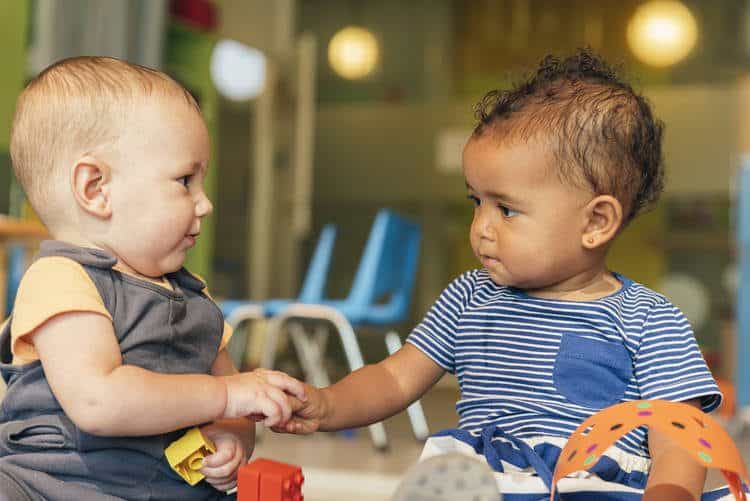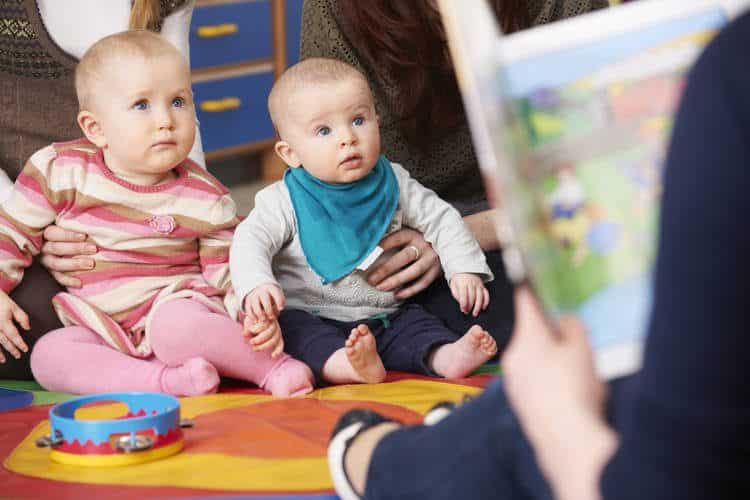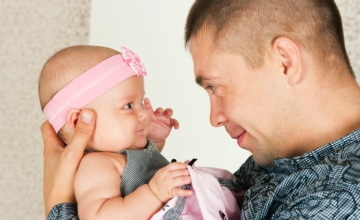Jasmine M. DeJesus, University of North Carolina at Greensboro
Zoe Liberman, University of California, Santa Barbara
Katherine D. Kinzler, Cornell University

Abstract
Babies are miraculous linguistic creatures. From an early age, they seamlessly master the language or languages in their early environment. Babies’ early language-learning abilities turn out to not just be about language—they are also social in nature, orienting children to cultural in-group members. Infants and young children demonstrate preferences for people who speak in a familiar language or accent, and they selectively learn from those people. In this article, the authors discuss how early social preferences toward language develop, their function for learning about one’s culture and community, and how thinking about language may relate to later social biases. They also examine how children’s attitudes toward speakers of different languages may be flexible based on children’s experiences, including differences in children’s own cultural backgrounds and exposure to diversity. Language is a critical component of identity and culture, and children pick up on this right away.
Infants and young children are experts at learning language. In a matter of just a few years, children can seemingly miraculously turn from babies to proficient speakers of a native language (or languages). Adults often struggle to learn a new language, such as when a college student takes an introductory course, yet young children can master a language or multiple languages without explicit instruction.
This article shows that humans’ remarkable linguistic ability is not just for learning languages: Language is also social, communicative, and critical for identity. From birth, babies begin to master their native language or languages as part of their cultural identity. We first showcase how quickly infants are able to zero in on the sounds of their native tongue. Next, we show how this early attention to “native” lays the groundwork for learning and for social identity. Finally, we discuss how children in diverse linguistic contexts may learn about the social meaning of language in different ways. In sum, language is a critical component of social life. Babies pick up on the social nature of language right away, and the attention paid to people who speak their native language structures children’s early interactions with their social world.
Language From Birth: Listening to Learn
Babies are born orienting toward language. Newborn infants can tell the difference between speech and non-speech (Peña et al., 2003; Ramus, Hauser, Miller, Morris, & Mehler, 2000) and prefer to listen to humans talking than to musical tones (Vouloumanos & Werker, 2004, 2007). Infants are especially interested in listening to the speech of people who may be important to their social world. Right away, they prefer to listen to their mother’s voice over other people’s voices (DeCasper & Fifer, 1980). They also like the sound of a familiar language compared to the sound of a less familiar language (Mehler et al., 1988; Moon, Cooper, & Fifer, 1993). Babies can even tell the sounds of two foreign languages apart, provided that they are sufficiently different, for instance when they cross a rhythmic boundary (Nazzi, Bertoncini, & Mehler, 1998).
How do researchers know what infants are hearing and thinking? To learn what infants know before they start to speak, researchers capitalize on infants’ natural behaviors, such as sucking and looking. For instance, to determine whether infants can distinguish between two different languages (e.g., the language spoken by their mothers and a different language), researchers might measure how much they suck on a specially designed pacifier that can measure infants’ rate of sucking (Mehler et al., 1988; Vouloumanos & Werker, 2007), how long infants look at the people who speak in those languages (Kinzler, Dupoux, & Spelke, 2007), or whether infants turn their heads toward the sound of a particular person speaking (Werker, Polka, & Pegg, 1997; Werker & Tees, 1984). More sucking or looking (or looking to the right or the left) is interpreted as more interest in what infants are hearing or seeing.
Slightly later in development, when older infants can reach for objects, give objects to another person, or imitate another person’s actions, researchers can monitor an infant’s behaviors (Buttelmann, Zmyj, Daum, & Carpenter, 2012; Kinzler et al., 2007; Kinzler, Dupoux, & Spelke, 2012). In this case, researchers interpreted the preference based on who the infant decided to interact with, approach, or imitate. In some studies, researchers even measured neural activity using devices specially designed for infants and young children—these devices measured electrical activity or patterns of blood flow in the brain while infants and children passively listened to audio input or watched short videos (Begus, Gliga, & Southgate, 2016). Researchers measured infants’ reactions using whatever behaviors infants are capable of at that age (sucking, listening, looking, reaching).
As babies grow, they continue to orient toward their native language. Over the first year of life, babies’ ability to tell the difference between different languages improves—provided that one of the languages is their own. For instance, a newborn baby might think that Dutch and English sound similar; but after a half a year of hearing one or the other language, babies can tell that they sound different (Nazzi, Jusczyk, & Johnson, 2000). (Yet to a French-learning 6-month-old, English and Dutch might still sound about the same.) With age, babies get better at hearing linguistic differences that they are familiar with, yet their ability to discriminate linguistic differences that they do not hear regularly declines. Babies are getting tuned up to their native language—and losing sensitivity for non-native linguistic contrasts (Gervain & Mehler, 2009; Werker & Tees, 1984).
Even in the first year of life, babies know that language has an important social function: People speak to each other to communicate, and babies are continually orientated to speakers of their native language. In addition to tuning their linguistic skills to learn to talk themselves, babies are also honing their skills for picking out native speakers whom they might orient toward, interact with, and learn from. For example, after watching videos of two people, one who spoke the infant’s native language and one who spoke a foreign language, infants preferred to interact with the native speaker. That is, they looked longer at the native speaker (Kinzler et al., 2007), and, when both speakers offered the infant identical toys, infants were more likely to take the toy from the person who spoke their native language (Kinzler et al., 2007). These preferences also emerged in contexts that appear more relevant to learning: After seeing a native speaker eat one food and a foreign speaker eat a different food, infants copied the food choice of the native speaker (Shutts, Kinzler, McKee, & Spelke, 2009). Infants who saw a native speaker demonstrate a new action were also more likely to imitate that action than infants who saw the same action done by a foreign speaker (Buttelmann et al., 2012; Howard, Henderson, Carrazza, & Woodward, 2014).
Why do infants seem to understand so much about language before they are talking themselves? One possibility is that babies are thinking about who speaks in which way to figure out who may be a relevant teacher. Infants rely on other people to survive, so they may be looking for potential social partners from their group to build social relationships with and for people who can teach them important things about their community. In fact, researchers found more theta activity (a neural rhythm that indicates preparation for learning) when infants watched a video of a native speaker compared to when they watched a video of a foreign speaker (Begus et al., 2016). Infants also seem to understand from a more abstract perspective that language can be used to transfer information across people. They expected that other people use language (but not other noises) to communicate information and make requests of each other (Martin, Onishi, & Vouloumanos, 2012; Vouloumanos, 2018; Vouloumanos, Martin, & Onishi, 2014; Vouloumanos, Onishi, & Pogue, 2012).
As children age from infancy to the preschool years, they continue to learn from native speakers around them (Kinzler, Corriveau, & Harris, 2011). In one study, children were introduced to two people: One spoke in English using an American accent and one spoke in English using a Spanish accent (children who participated in the study were monolingual English speakers living in the United States). Each person then demonstrated a possible way to use an unfamiliar object. For instance, children were shown a juicer, which one person rolled and the other used as a hammer. When asked how the object should be used, children were more likely to choose the native speaker’s action as correct, regardless of whether the native speaker had rolled or hammered. The child chose the action of the native-accented speaker even when the native and foreign-accented speaker both first spoke in nonsense speech. They each said something that was equally nonsensical and semantically uninterpretable; nonetheless, children chose to learn from the native-accented person.

Language is social, communicative, and critical for identity. Photo: santypan/shutterstock
It is important to realize, though, that children do not select native-accented speakers at all costs. When a native-accented speaker revealed themselves to be a poor informant in the past (e.g., by erroneously labeling a brush a “plate”), children could easily switch to prioritizing the information provided by a more knowledgeable, but foreign-accented, speaker (Corriveau, Kinzler, & Harris, 2013). Nevertheless, at first glance—without information to suggest otherwise—infants and children are drawn to native speakers for providing relevant and learnable information. They might initially trust native speakers to know the names of new objects, what is safe to eat, and what is fun to play with in their community. Unless the native speaker provides evidence that she is not indeed a reliable teacher, as a baseline, infants and children will preferentially learn from and imitate her.
Language as a Marker of Social Identity
In addition to serving as a tool for communication and social learning, language is an important part of social and cultural identity. It is hard to pinpoint the degree to which babies may feel that they have an “identity.” Nevertheless, it seems likely that babies are orienting to some people over others not just for learning, but also for social engagement. As discussed previously, within the first year of life, babies start to orient toward, interact with, and learn from people who speak in a familiar language. In other studies, we have tried to understand the degree to which young babies start to think about language as providing information about people’s social place in the world. Do infants possess a rudimentary understanding of social groups? Do they start to think about other people as not just individuals, but as part of a social network where they may share relationships or relevant preferences with others? To the best of researchers’ understanding, it seems that infants do begin to develop a naïve sense of the sociological world, and language plays an important role in this early understanding.
In one study, we showed 9-month-old English-hearing infants two people who either spoke the same language (both people spoke English) or two different languages (one person spoke English and the other spoke Spanish). Using a looking-time method that measures infants’ gaze and often finds that babies look longer to events that are novel or surprising, we found that babies had early social expectations. When two people spoke the same language, babies thought it was surprising when those people subsequently disengaged and acted as if they did not like each other very much. In contrast, when two people spoke different languages, babies thought it was surprising when those people turned toward each other, smiled, and waved at each other, acting as if they liked each other. In short, infants made predictions about two people’s subsequent social actions based on whether they first spoke the same or different languages (Liberman, Woodward, & Kinzler, 2017). Babies see language as tied to social relationships. In a related study, monolingual babies expected that two people who spoke the same language (both English or both Spanish) would like to eat the same foods—but they did not necessarily think that a speaker of English and a speaker of Spanish would enjoy eating the same things (Liberman, Woodward, Sullivan, & Kinzler, 2016). It was interesting that English-hearing babies could make predictions about two Spanish speakers (thinking they would like to eat the same things as each other) just as well as they could think about two English speakers. Babies seem to be able to think about social relationships that extend beyond themselves and their local social worlds—and they conclude that people who talk the same are like each other in meaningful ways.
As children get older, it becomes much easier methodologically to test their thoughts about the way that language can structure social groups and define people’s feelings of identity within a group. With older children, researchers can just ask them what they think and they will tell them. When asked who they would prefer as a potential friend, 5- and 6-year-old children tend to select people who speak in their own language with a native accent, even if they understand the non-native accent perfectly well (Kinzler & DeJesus, 2013a; Kinzler, Shutts, DeJesus, & Spelke, 2009). Indeed, native language preferences override preferences based on other types of familiarity. For instance, when presented with a choice between a person who speaks in their native language but is from a different racial background (i.e., a White English-speaking participant is shown a Black child who speaks native English) and a child who shares their racial background but speaks in a different accent (i.e., a White child who speaks with a French accent), children selected the child who shares their accent as a friend (Kinzler et al., 2009). Similar to children’s learning about objects, children did not select native speakers as friends at all costs—they avoided native speakers with a history of mean behavior (e.g., pushing someone down on the playground or ripping up their sibling’s homework) and instead selected foreign-accented speakers who have behaved nicely as friends (Kinzler & DeJesus, 2013a). Nonetheless, without additional information, children tend to gravitate toward friends who share their language or accent.
Relatedly, young children see language as an important and enduring feature of identity: They expect language to be stable over time, and perhaps even heritable. For instance, when asked whether a child adopted at birth will grow up to speak the language of their birth parents or of their adoptive parents, 5-year-old children expected language to be fixed by birth parenting (Hirschfeld & Gelman, 1997). In some circumstances, young children even indicated that they think the language someone speaks is more stable than their race. When presented with a target child and asked which of two adults the child would grow up to be, young White children (5–6 years old) were more likely to choose an adult who matched the target child’s language (but was of a different race), than they were to choose an adult who matched the target child’s race (but spoke a different language; Dautel & Kinzler, 2017; Kinzler & Dautel, 2012). Older children (9- and 10-year-olds), however, thought that skin color was more stable than language. Older kids reported that someone might be able to learn to speak a new language, or perhaps the person spoke two languages to begin with. Younger children, in contrast, were more likely to view language as stable—enough so that they sometimes thought someone might dramatically transform physical appearance yet maintain the same language. It is interesting that younger Black children (5- and 6-year-olds) performed similarly to older White children—they expected the person’s race to remain constant, suggesting that differences in children’s experiences likely shape their views about language, race, and identity.

Babies pick up on the social nature of language right away, and the attention paid to people who speak their native language structures children’s early interactions with their social world. Photo: SpeedKingz/shutterstock
As children age, they begin making a variety of judgments about other people on the basis of the language or accent with which they speak. For example, 5-year-old children expect that native language speakers will be more likely that foreign language speakers to eat typical foods (DeJesus, Gerdin, Sullivan, & Kinzler, in press). And children demonstrate early associations between language and nationality. For example, preschool-aged children assumed that people who share an accent are likely from the same geographic area (Weatherhead, White, & Friedman, 2016). Young children attended to language more than to other features of people, such as race, when predicting a person’s likely nationality (DeJesus, Hwang, Dautel, & Kinzler, 2018). Finally, there is evidence that language starts to structure moral circles. When children learn about fictional groups where one harms another, they say it is not permissible to harm, regardless of whether or not an authority figure says it’s OK. But what if these fictional groups cross linguistic lines? Here, children were less sure (Rhodes & Chalik, 2013). Harm across linguistic groups is seen as somewhat less problematic. Children are drawing in-group and out-group circles, and they see language an easy way to draw those lines. Taken together, these findings suggest that infants and young children have strong intuitions connecting language and identity and that language fundamentally structures their perceptions of the social world.
How Do Children's Diverse Experiences Contribute to Their Thinking About Identity?
Children in different social environments may develop a different conceptualization of language as structuring social identity. First, as children aged, they began to understand that different languages and accents are imbued with different cultural stereotypes (Giles & Billings, 2004). They may transition from preferring “native” speech to preferring speech that is seen as being higher in cultural status (Day, 1980; Lambert, Frankle, & Tucker, 1966). For instance, we have found that by 9 years old, kids who live both in the North and the South of the United States begin to endorse linguistic stereotypes about how northerners sound “smart” and southerners sound “nice” (Kinzler & DeJesus, 2013b). The specific cultural stereotypes associated with any given language or accent may vary according to where children live and their social experiences. That said, children in all places are cultural sponges ready to absorb those stereotypes—whatever they may be in their local environment.

Young children see language as an important and enduring feature of identity. Photo: Patrick Foto/shutterstock
Second, although much of the research we have discussed so far focused on experiences of infants and children in the United States who hear and speak English, the world is a multilingual place. A majority of the world’s children grow up exposed to more than one language (Grosjean, 2010). Conducting research with children from diverse backgrounds and in different contexts is critical to better understand early development more broadly and their reasoning about identity more specifically (see Nielsen, Haun, Kärtner, & Legare, 2017).
In many ways, monolingual and bilingual children think about language and social identity in similar ways. Children from varied linguistic backgrounds demonstrated social preferences based on language and accent (Kinzler, Shutts, & Spelke, 2012; Souza, Byers-Heinlein, & Poulin-Dubois, 2013). Yet, bilingual children were socially receptive to people who speak both their languages (not just one), and to people who were monolingual or bilingual, but not to people who spoke with non-native accents (Byers-Heinlein, Behrend, Said, Girgis, & Poulin-Dubois, 2017; DeJesus, Hwang, Dautel, & Kinzler, 2017), In addition to the languages that children heard at home or spoke themselves, the language diversity of their community shaped early reasoning about language—even among infants who only heard English from parents and caregivers, infants who lived in neighborhoods with more linguistic diversity imitated more actions performed by Spanish speakers (Howard, Carrazza, & Woodward, 2014). Compared to strictly monolingual children, bilingual children and monolingual children with regular exposure to linguistic diversity also more easily took the perspective of people they have just met (Fan, Liberman, Keysar, & Kinzler, 2015; Yow & Markman, 2015). Finally, in our studies in which we tested babies’ thinking about who likes to eat which foods, bilingual babies seemed to think that all people would share food preferences—even if those people spoke in different languages (Liberman et al., 2016). In sum, these findings highlight that experience hearing multiple languages influences the specifics of children’s early social preferences, nonetheless the tendency to use language to structure the social world is common across infants and children with diverse experiences.
Conclusion
Infants and young children demonstrated preferences for people who speak in their native language (and with a native accent) at a very early age. These preferences can be functional: They draw children’s attention to members of their community, which might have important implications for learning language and cultural information. These preferences may also have negative consequences: They are easily learned and, though the specific content of social preferences is flexible, preferences emerge early across cultures. Infants and young children may expect relatively more familiar adults to be more likely to provide relevant information and to serve as teachers. They also demonstrate preferences for people who are like them and tend to affiliate with members of their own cultural group. By early childhood, children use information about cultural group membership to make many types of social judgments and inferences about a person’s background. These developing biases are important to understand, as they may have consequences for how children perceive people who are different from themselves across the lifespan.
Learn More
The Development of Social Cognition Lab is based at Cornell University and is directed by Katherine Kinzler
https://dsclabcornell.com
The Social Cognitive Development Lab is based at the University of California, Santa Barbara and is directed by Zoe Liberman
https://labs.psych.ucsb.edu/liberman/zoe
The Development, Culture, and Health Lab is based at the University of North Carolina at Greensboro and is directed by Jasmine DeJesus
https://www.devculturehealth.com
Acknowledgments
We acknowledge support from the National Institute of Child Health and Human Development Grant R01HD070890 to K.D.K.
Authors
Jasmine M. DeJesus, PhD, is an assistant professor in the Department of Psychology at the University of North Carolina at Greensboro. She received her doctorate from the University of Chicago and her bachelor’s degree from Harvard University. As the director of the Development, Culture, and Health Lab, she studies the development of social cognition and is especially interested in examining children’s social reasoning in the context of food. The domain of food provides particularly interesting opportunities to examine questions about social learning and cultural group membership across the lifespan and to consider the implications of basic research for pressing public health issues.
Zoe Liberman, PhD, is an assistant professor in the Department of Psychological & Brain Sciences at the University of California, Santa Barbara. She received her doctorate from University of Chicago and her bachelor’s degree from Yale University. As the director of the Social Cognitive Development Lab, she investigates the origins of human social reasoning and social learning. In particular, her work focuses on how infants reason about the structure of social world and how their initial understanding is shaped by experience and development.
Katherine D. Kinzler, PhD, is an associate professor in the Department of Psychology at Cornell. She received a doctorate in psychology from Harvard University, a bachelor’s degree in cognitive science from Yale University, and she was a Fulbright Scholar at the École Normale Supérieure in Paris. As director of the Development of Social Cognition Lab at Cornell, she studies children’s early intuitions about the social world. Much of her research focuses on how language and accent mark social groups beginning early in life. Her work has appeared in the New York Times and other outlets, and she was recognized as a “Young Scientist” by the World Economic Forum.
Suggested Citation
DeJesus, J. M., Liberman, Z., & Kinzler, K. D. (2019). Early origins of identity: Infants' and children's thinking about language and culture. ZERO TO THREE Journal, 39(3), 10–16.
References
Begus, K., Gliga, T., & Southgate, V. (2016). Infants’ preferences for native speakers are associated with an expectation of information. Proceedings of the National Academy of Sciences, 113(44), 12397–12402. doi: 10.1073/pnas.1603261113
Buttelmann, D., Zmyj, N., Daum, M., & Carpenter, M. (2012). Selective imitation of in-group over out-group members in 14-month-old infants. Child Development, 84(2), 422–428. doi: 10.1111/j.1467-8624.2012.01860.x
Byers-Heinlein, K., Behrend, D. A., Said, L. M., Girgis, H., & Poulin-Dubois, D. (2017). Monolingual and bilingual children’s social preferences for monolingual and bilingual speakers. Developmental Science, 20(4), e12392. doi: 10.1111/desc.12392
Corriveau, K. H., Kinzler, K. D., & Harris, P. L. (2013). Accuracy trumps accent in children’s endorsement of object labels. Developmental Psychology, 49(3), 470–479. doi: 10.1037/a0030604
Dautel, J. B., & Kinzler, K. D. (2017). Once a French speaker, always a French speaker? Bilingual children’s thinking about the stability of language. Cognitive Science, 42(S1), 287–302. doi: 10.1111/cogs.12572
Day, R. R. (1980). The development of linguistic attitudes and preferences. TESOL Quarterly, 14(1), 27–37. doi: 10.2307/3586806
DeCasper, A., & Fifer, W. (1980). Of human bonding: Newborns prefer their mothers’ voices. Science, 208(4448), 1174–176 doi: 10.1126/science.7375928
DeJesus, J. M., Gerdin, E., Sullivan, K. R., & Kinzler, K. D. (in press). Children judge others based on their food choices. Journal of Experimental Child Psychology.
DeJesus, J. M., Hwang, H. G., Dautel, J. B., & Kinzler, K. D. (2017). Bilingual children’s social preferences hinge on accent. Journal of Experimental Child Psychology, 164, 178–191. doi: 10.1016/j.jecp.2017.07.005
DeJesus, J. M., Hwang, H. G., Dautel, J. B., & Kinzler, K. D. (2018). “American = English speaker” before “American = White”: The development of children’s reasoning about nationality. Child Development, 89(5), 1752–1767. doi: 10.1111/cdev.12845
Fan, S. P., Liberman, Z., Keysar, B., & Kinzler, K. D. (2015). The exposure advantage: Early exposure to a multilingual environment promotes effective communication. Psychological Science, 26(7), 1090–1097. doi: 10.1177/0956797615574699
Gervain, J., & Mehler, J. (2009). Speech perception and language acquisition in the first year of life. Annual Review of Psychology, 61(1), 191–218. doi: 10.1146/annurev.psych.093008.100408
Giles, H., & Billings, A. C. (2004). Assessing language attitudes: Speaker evaluation studies. In A. Davies & E. Elder (Eds.), The handbook of applied linguistics (pp. 187–209). Oxford, England: Blackwell. doi: 10.1002/9780470757000.ch7
Grosjean, F. (2010). Bilingual. Cambridge, MA: Harvard University Press.
Hirschfeld, L. A., & Gelman, S. A. (1997). What young children think about the relationship between language variation and social difference. Cognitive Development, 12(2), 213–238. doi: 10.1016/S0885-2014(97)90014-9
Howard, L. H., Carrazza, C., & Woodward, A. L. (2014). Neighborhood linguistic diversity predicts infants’ social learning. Cognition, 133(2), 474–479. doi: 10.1016/j.cognition.2014.08.002
Howard, L. H., Henderson, A. M. E., Carrazza, C., & Woodward, A. L. (2014). Infants’ and young children’s imitation of linguistic in-group and out-group informants. Child Development, 86(1), 259–275. doi: 10.1111/cdev.12299
Kinzler, K. D., Corriveau, K. H., & Harris, P. L. (2011). Children’s selective trust in native-accented speakers. Developmental Science, 14(1), 106–111. doi: 10.1111/j.1467-7687.2010.00965.x
Kinzler, K. D., & Dautel, J. B. (2012). Children’s essentialist reasoning about language and race. Developmental Science, 15(1), 131–138. doi: 10.1111/j.1467-7687.2011.01101.x
Kinzler, K. D., & DeJesus, J. M. (2013a). Children’s sociolinguistic evaluations of nice foreigners and mean Americans. Developmental Psychology, 49(4), 655–664. doi: 10.1037/a0028740
Kinzler, K. D., & DeJesus, J. M. (2013b). Northern = smart and Southern = nice: The development of accent attitudes in the United States. The Quarterly Journal of Experimental Psychology, 66(6), 1146–1158. doi: 10.1080/17470218.2012.731695
Kinzler, K. D., Dupoux, E., & Spelke, E. S. (2007). The native language of social cognition. Proceedings of the National Academy of Sciences, 104(30), 12577–12580. doi: 10.1073/pnas.0705345104
Kinzler, K. D., Dupoux, E., & Spelke, E. S. (2012). “Native” objects and collaborators: Infants’ object choices and acts of giving reflect favor for native over foreign speakers. Journal of Cognition and Development, 13(1), 67–81. doi: 10.1080/15248372.2011.567200
Kinzler, K. D., Shutts, K., DeJesus, J. M., & Spelke, E. S. (2009). Accent trumps race in guiding children’s social preferences. Social Cognition, 27(4), 623–634. doi: 10.1521/soco.2009.27.4.623
Kinzler, K. D., Shutts, K., & Spelke, E. S. (2012). Language-based social preferences among children in South Africa. Language Learning and Development, 8(3), 215–232. doi: 10.1080/15475441.2011.583611
Lambert, W. E., Frankle, H., & Tucker, G. R. (1966). Judging personality through speech: A French-Canadian example. Journal of Communication, 16(4), 305–321. doi: 10.1111/j.1460-2466.1966.tb00044.x
Liberman, Z., Woodward, A. L., & Kinzler, K. D. (2017). Preverbal infants infer third-party social relationships based on language. Cognitive Science, 41, 622–634. doi: 10.1111/cogs.12403
Liberman, Z., Woodward, A. L., Sullivan, K. R., & Kinzler, K. D. (2016). Early emerging system for reasoning about the social nature of food. Proceedings of the National Academy of Sciences, 113(34), 9480–9485. doi: 10.1073/pnas.1605456113
Martin, A., Onishi, K. H., & Vouloumanos, A. (2012). Understanding the abstract role of speech in communication at 12 months. Cognition, 123(1), 50–60. doi: 10.1016/j.cognition.2011.12.003
Mehler, J., Jusczyk, P., Lambertz, G., Halsted, N., Bertoncini, J., & Amiel-Tison, C. (1988). A precursor of language acquisition in young infants. Cognition, 29(2), 143–178. doi: 10.1016/0010-0277(88)90035-2
Moon, C., Cooper, R. P., & Fifer, W. P. (1993). Two-day-olds prefer their native language. Infant Behavior & Development, 16(4), 495–500. doi: 10.1016/0163-6383(93)80007-U
Nazzi, T., Bertoncini, J., & Mehler, J. (1998). Language discrimination by newborns: Toward an understanding of the role of rhythm. Journal of Experimental Psychology: Human Perception and Performance, 24(3), 756–766. doi: 10.1037/0096-1523.24.3.756
Nazzi, T., Jusczyk, P. W., & Johnson, E. K. (2000). Language discrimination by English-learning 5-month-olds: Effects of rhythm and familiarity. Journal of Memory and Language, 43(1), 1–19. doi: 10.1006/jmla.2000.2698
Nielsen, M., Haun, D., Kärtner, J., & Legare, C. H. (2017). The persistent sampling bias in developmental psychology: A call to action. Journal of Experimental Child Psychology, 162, 31–38. doi: 10.1016/j.jecp.2017.04.017
Peña, M., Maki, A., Kovacɮić, D., Dehaene-Lambertz, G., Koizumi, H., Bouquet, F., & Mehler, J. (2003). Sounds and silence: An optical topography study of language recognition at birth. Proceedings of the National Academy of Sciences, 100(20), 11702–11705. doi: 10.1073/pnas.1934290100
Ramus, F., Hauser, M. D., Miller, C., Morris, D., & Mehler, J. (2000). Language discrimination by human newborns and by cotton-top tamarin monkeys. Science, 288(5464), 349–351. doi: 10.1126/science.288.5464.349
Rhodes, M., & Chalik, L. (2013). Social categories as markers of intrinsic interpersonal obligations. Psychological Science, 24(6), 999–1006. doi: 10.1177/0956797612466267
Shutts, K., Kinzler, K. D., McKee, C. B., & Spelke, E. S. (2009). Social information guides infants’ selection of foods. Journal of Cognition and Development, 10(1–2), 1–17. doi: 10.1080/15248370902966636
Souza, A. L., Byers-Heinlein, K., & Poulin-Dubois, D. (2013). Bilingual and monolingual children prefer native-accented speakers. Frontiers in Psychology, 4, 953–958. doi: 10.3389/fpsyg.2013.00953
Vouloumanos, A. (2018). Voulez-vous jouer avec moi? Twelve-month-olds understand that foreign languages can communicate. Cognition, 173, 87–92. doi: 10.1016/j.cognition.2018.01.002
Vouloumanos, A., Martin, A., & Onishi, K. H. (2014). Do 6-month-olds understand that speech can communicate? Developmental Science, 17(6), 872–879. doi: 10.1111/desc.12170
Vouloumanos, A., Onishi, K. H., & Pogue, A. (2012). Twelve-month-old infants recognize that speech can communicate unobservable intentions. Proceedings of the National Academy of Sciences, 109(32), 12933–12937. doi: 10.1073/pnas.1121057109
Vouloumanos, A., & Werker, J. F. (2004). Tuned to the signal: The privileged status of speech for young infants. Developmental Science, 7(3), 270–276. doi: 10.1111/j.1467-7687.2004.00345.x
Vouloumanos, A., & Werker, J. F. (2007). Listening to language at birth: Evidence for a bias for speech in neonates. Developmental Science, 10(2), 159–164. doi: 10.1111/j.1467-7687.2007.00549.x
Weatherhead, D., White, K. S., & Friedman, O. (2016). Where are you from? Preschoolers infer background from accent. Journal of Experimental Child Psychology, 143, 171–178. doi: 10.1016/j.jecp.2015.10.011
Werker, J. F., Polka, L., & Pegg, J. E. (1997). The conditioned head turn procedure as a method for testing infant speech perception. Infant and Child Development, 6(3–4), 171–178.
Werker, J. F., & Tees, R. C. (1984). Cross-language speech perception: Evidence for perceptual reorganization during the first year of life. Infant Behavior and Development, 7(1), 49–63. https://doi.org/10.1016/S0163-6383(84)80022-3
Yow, W. Q., & Markman, E. M. (2015). A bilingual advantage in how children integrate multiple cues to understand a speaker’s referential intent. Bilingualism: Language and Cognition, 18(3), 391–399. doi: 10.1017/S1366728914000133




